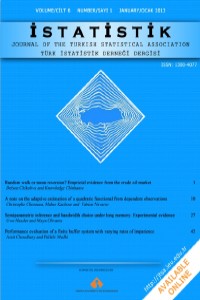Abstract
The paper investigates and gives an update on the empirical evidence for or against the random walk theory in the crude oil market. The paper investigates whether there are periods when crude oil prices follow the random walk process and periods when they deviate from the random walk theory (mean reverting). Various studies often give conflicting results for the same study period. Some computations conducted over the period of 2000-2005 lead to inconclusive results (Geman, 2007), suggesting that more work remains to be done in this period and beyond. It is imperative to revisit mean reversion and random walk in the context of crude oil as it has serious implication on modeling crude oil prices. In this paper, a Garch model with time-varying properties is applied to capture periods when the random walk theory may be true and periods when it may be false. This study concludes the existence of mean reversion for crude oil price over the period 1980 to 1994 and a random walk as of February 1994 to the end of the study period in 2010. Prior to February 1994 some models, like arima models, might have been valid. Beyond this period, models need to recognize the random walk in crude oil returns.
References
- Bessembinder, H., Coughenour, J., Seguin, P. & Smoller, M. (1995) Mean reversion in equilibrium asset prices: Evidence from the futures term structure. Journal of Finance, 50: 361-375.
- Bernard, S.T., Khalaf, L., Kichian, M. & McMahon, S. (2008) Oil prices: Heavy Tails, Mean Reversion and the convenience Yield. Available on line: http://ideas.repec.org/p/lvl/lagcr/0801.html
- Cheong, C.W. (2009) Modeling and forecasting crude markets using ARCH-type models. Energy policy, 2346-2355.
- Cheung, Y.W. and Lai, K.S. (1995) Log Order and critical values of the Augmented Dickey-Fuller Test. Journal of Business and Economic Statistics, 13(3): 277-280.
- Campbell, J.Y., Lo, A.W. & Mackinlay, A.C. (1997) The Econometrics of Financial Markets, Princeton: Princeton University Press.
- Emerson, R., Hall, S.G. & Zalaweska-Mitura, A. (1997) Evolving Market Efficiency with an application to some Bulgarian shares. Economics of planning, 30(1): 75-90.
- Geman, H. (2007)Mean Reversion versus RandomWalk in Oil and Natural Gas Prices. United Kingdom: University of London.
- Harvey, H., Ruiz, E & Sentona, E. (1992) Unobserved component time series models with ARCH disturbances. Journal of Econometrics 52: 129-157.
- Jefferies, K. & Smith, G. (2005) The changing efficiency of African stock markets. South African Journal of Economics, 73: 54-67.
- Lo, A.W. & Mackinlay, A.C. (1999) A Non-Random Walk down Wall Street. Princeton: Princeton University Press.
- Moonis, S.A. & Shar, A. (2008) Teseting the time variation in beta in India. Journal of Emerging Markets Finance, 2(2): 163-180.
- Pindyck, R.S. (1999) The long run evolution of energy prices. The Energy Journal 20: 1-27.
- Zalewska-Mitura, A. & Hall, S.G.] (1999) Examining the first stages of market performance: a test for evolving market efficiency. Economics Letters, 64: 1-12. The mongabay website http://www.mongabay.com/commodities/price-charts/price-of-uk-brent-oil.html [Accessed 22July 2012]
Abstract
References
- Bessembinder, H., Coughenour, J., Seguin, P. & Smoller, M. (1995) Mean reversion in equilibrium asset prices: Evidence from the futures term structure. Journal of Finance, 50: 361-375.
- Bernard, S.T., Khalaf, L., Kichian, M. & McMahon, S. (2008) Oil prices: Heavy Tails, Mean Reversion and the convenience Yield. Available on line: http://ideas.repec.org/p/lvl/lagcr/0801.html
- Cheong, C.W. (2009) Modeling and forecasting crude markets using ARCH-type models. Energy policy, 2346-2355.
- Cheung, Y.W. and Lai, K.S. (1995) Log Order and critical values of the Augmented Dickey-Fuller Test. Journal of Business and Economic Statistics, 13(3): 277-280.
- Campbell, J.Y., Lo, A.W. & Mackinlay, A.C. (1997) The Econometrics of Financial Markets, Princeton: Princeton University Press.
- Emerson, R., Hall, S.G. & Zalaweska-Mitura, A. (1997) Evolving Market Efficiency with an application to some Bulgarian shares. Economics of planning, 30(1): 75-90.
- Geman, H. (2007)Mean Reversion versus RandomWalk in Oil and Natural Gas Prices. United Kingdom: University of London.
- Harvey, H., Ruiz, E & Sentona, E. (1992) Unobserved component time series models with ARCH disturbances. Journal of Econometrics 52: 129-157.
- Jefferies, K. & Smith, G. (2005) The changing efficiency of African stock markets. South African Journal of Economics, 73: 54-67.
- Lo, A.W. & Mackinlay, A.C. (1999) A Non-Random Walk down Wall Street. Princeton: Princeton University Press.
- Moonis, S.A. & Shar, A. (2008) Teseting the time variation in beta in India. Journal of Emerging Markets Finance, 2(2): 163-180.
- Pindyck, R.S. (1999) The long run evolution of energy prices. The Energy Journal 20: 1-27.
- Zalewska-Mitura, A. & Hall, S.G.] (1999) Examining the first stages of market performance: a test for evolving market efficiency. Economics Letters, 64: 1-12. The mongabay website http://www.mongabay.com/commodities/price-charts/price-of-uk-brent-oil.html [Accessed 22July 2012]
Details
| Primary Language | English |
|---|---|
| Journal Section | Articles |
| Authors | |
| Publication Date | January 1, 2013 |
| Acceptance Date | August 9, 2012 |
| Published in Issue | Year 2013 Volume: 6 Issue: 1 |


